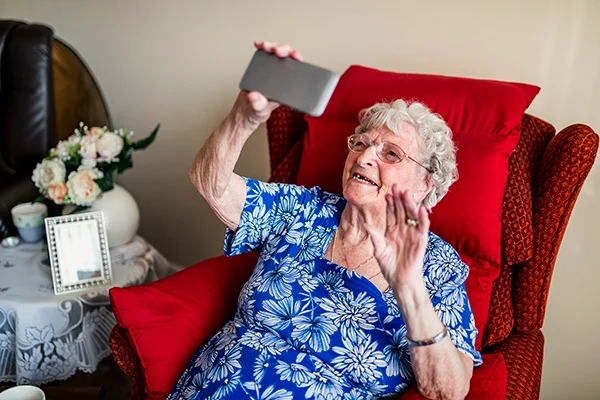
With shelter-in-place and physical-distancing orders, many people have started to move even more of their lives onto their devices. Work meetings, happy hours and classes are all taking place now via apps like Skype, Zoom, WhatsApp and Google Hangouts.
But there are still those who don’t know how to use video apps but would benefit from the interaction.
“It is more important, now more than ever, to ensure physical-distancing and shelter-in-place orders for infection prevention don’t worsen social isolation for older adults in our families and in our communities,” said Peggy Budai, a nurse practitioner for UCHealth specializing in geriatric care. “Social isolation can be especially hard on the mental and physical health of older adults. But research also shows that video chatting can reduce the risk of depression in this population.”
Why video chat?
While it’s nice to call your family on the phone to check in, video chatting provides a deeper connection. You have the benefit of physically seeing how someone else is doing, and there is also the opportunity to share visually, maybe the quilt you’ve been working on or the cute little faces of grandchildren.
And once the technology is set up, it can be a daily resource for them. They can join virtual classes or events, have video lunch dates with friends or participate in an online book club or Bible study.
How can I help someone get connected?
“Be patient, breathe easy and go slow,” advised Chris Kennedy, owner of AppleCore Technology. Kennedy helps many older adults remotely with their computer challenges.
- Go with the most user-friendly app, not just what you are using.
- Give them an instruction, make sure they understand, and have them do that before you move on to the next step.
- Instead of telling them a command, such as click on “finder,” explain where that link is on their screen: “Finder is that square blue and gray box with a smiley face on it at the bottom of your screen. Click on that.”
- Listen first to them explain what they did, then clarify your instructions in a way that doesn’t make them feel dumb or attacked.
“If you are getting too frustrated, just let them know you have another call and that you’ll call them right back,” Kennedy advised. “The more anger in your voice, the more frustrated they will get. Remember, you’re trying to make that connection, not start a fight.”

When you’re trying to help remotely with more complicated computer issues than just a video chat, there are ways to “take control” of someone’s computer/mouse by using a “remote access” program.
TeamViewer is one remote access tool that’s free and easy to use. Both people need to download and install the QS (quick support) version. To take control of someone else’s computer, they will need to share the codes TeamViewer gives them. When you enter those codes on your device, you’ll be able to see their desktop and control the mouse as if it is yours.
What are some easy programs or apps to use for video chatting on your phone or tablet?
FaceTime
This is a great app for people who have Apple (iOS) devices. It’s already built into the iPhone and iPad so there is no downloading a new app or creating an account. The downfall is that you can only connect with other Apple devices. You can tell if someone has a compatible device if their contact info shows blue. People without an Apple device will show green.
To FaceTime another person, bring up their contact like you are going to call them but click on the icon that looks like a video camera instead of the telephone icon. It’s that easy.
Skype
Skype is a universal call, message and video chat program.
To get Skype, you need to download the app and set up a new account. Share your username with the person you want to connect with via Skype. Skype will save your new contacts into an address book for you.
The program is free, and you can use it to video call people outside the United States.

This is an encrypted communication tool used throughout the world for chat, voice and video calling. It is free, and it allows you to connect with people outside the U.S.
After loading the WhatsApp app on your phone, it will ask permission to access contacts. By accepting this, you can reach out to others with the app, or invite them to download the app so you can connect with them.
Google Hangouts
If you already have a Google account, then you’re set to go with Google Hangouts using the same gmail address and password. And if you’ve ever emailed anyone with their gmail address, then their contact information is already loaded into that account.
Facebook Messenger
If you have a Facebook account, then you can video chat with someone via Messenger. On your desktop, log in to Facebook, and on the right-hand column of the page, underneath “News Feed,” click on “Messenger.” From here, you can start a chat with a Facebook friend and video chat by clicking on the video camera icon.
On your phone, you open your Messenger app, find the person you want to video chat with and tap the video camera icon.
Messenger tells you if a person is “active” under their name. If they are not currently using Facebook, then they may not answer your call.
Zoom:
Zoom is typically used for business. But it is free to set up an account, and it may be worth trying if more than two people want to video chat, such as over Easter dinner. It only takes a minute to sign up and is fairly user-friendly.
For all updates and to read more articles about the new coronavirus, please visit uchealth.org/covid19
Microsoft Teams
Teams is also used more often for business, but again, it allows many people to video connect, share their screens, or just talk together at one time. Use an email as your username and create a password.
In both Teams and Zoom, you can create a calendar event/meeting and invite others to join. This way, invitees need only to click on the link within the calendar invite to join (and if they haven’t downloaded the app yet, the link will prompt them to do so). You can also use Teams through your internet browser and not download the app.
How do I find and/or download these programs or apps?
If you’re working on your desktop, you only need to Google the program’s name and it will walk you through how to download it for a Mac or PC. It may also give you an option to download it through the Apple’s App Store or Google Play, which is what you’ll use if you’re on your phone or tablet.
On your desktop, you download the program then install it onto your computer by opening the downloaded program and following the instructions. Some programs you can use via your internet browser so you don’t have to download and install the app.
To get an app for your phone, you go to the App Store (iPhone, iPads, etc.) or the Google Play (Android phones) and search for the program’s name. Then you load/open the app on your phone and go through the process to create an account.
Your username can be your email address or another name that you can then share with others you want to connect with via that app.
To use video chat programs on your computer, your monitor must have a camera.
However you connect, make sure to laugh
“Laughter can boost the immune system, reduce pain, reduce stress and increase our energy — and that is good medicine for all of us,” Budai said. “In serious times like this, it is not only OK but important for us to connect through video chat and through laughter.
“Make a plan to video chat with an older adult friend or relative today, and even better, share a funny moment and laugh together.”
